Analysis of Abnormal Sea Level Rise in Offshore Waters of Bohai Sea in 2024
Abstract
1. Introduction
2. Materials and Methods
2.1. Setups of the WRF
2.2. Setups of FVCOM-SWAVE
2.3. Forcing Fields and Boundary Conditions in FVCOM-SWAVE
2.4. Validation Sources
2.5. Stokes Transport Calculation
2.6. Statistic Parameter Formula
3. Results
3.1. Validation
3.2. Sensitive Experiment
3.3. The Relationship Between the Wind Speed, SWH, Imposed Boundary Current, and Sea Level
4. Discussion
5. Conclusions
Author Contributions
Funding
Data Availability Statement
Acknowledgments
Conflicts of Interest
References
- Woodworth, P.L.; Blackman, D.L. Changes in extreme high waters at Liverpool since 1768. Int. J. Clim. 2002, 22, 697–714. [Google Scholar] [CrossRef]
- Wang, X.L.; Zwiers, F.W.; Swail, V.R. North Atlantic Ocean wave climate change scenarios for the twenty-first century. J. Clim. 2004, 17, 2368–2383. [Google Scholar] [CrossRef]
- Hallegatte, S.; Ranger, N.; Mestre, O.; Dumas, P.; Corfee-Morlot, J.; Herweijer, C.; Wood, R.B. Assessing climate change impacts, sea level rise and storm surge risk in port cities: A case study on Copenhagen. Clim. Change 2011, 104, 113–137. [Google Scholar] [CrossRef]
- Yin, J. Rapid decadal acceleration of sea level rise along the U.S. East and Gulf coasts during 2010-22 and its impact on hurricane-induced storm surge. J. Clim. 2023, 36, 4511–4529. [Google Scholar] [CrossRef]
- Kleinosky, L.R.; Yarnal, B.; Fisher, A. Vulnerability of hampton roads, virginia to storm-surge flooding and sea-level rise. Nat. Hazards 2007, 40, 43–70. [Google Scholar] [CrossRef]
- Joyce, J.; Chang, N.B.; Harji, R.; Ruppert, T.; Singhofen, P. Cascade impact of hurricane movement, storm tidal surge, sea level rise and precipitation variability on flood assessment in a coastal urban watershed. Clim. Dyn. 2018, 51, 383–409. [Google Scholar] [CrossRef]
- Yang, Y.C.; Qi, J.P.; Yang, Q.S.; Fan, C.Q.; Zhang, R.; Zhang, J. Reconstruction of wide swath significant wave height from quasi-synchronous observations of multisource satellite sensors. Earth Space Sci. 2024, 11, e2023EA003162. [Google Scholar] [CrossRef]
- Woeppelmann, G.; Miguez, B.M.; Bouin, M.N.; Altamimi, Z. Geocentric sea-level trend estimates from gps analyses at relevant tide gauges world-wide. Glob. Planet. Change 2007, 57, 396–406. [Google Scholar] [CrossRef]
- Sun, Z.F.; Shao, W.Z.; Yu, W.P.; Li, J. A study of wave-induced effects on sea surface temperature simulations during typhoon events. J. Mar. Sci. Eng. 2021, 9, 622. [Google Scholar] [CrossRef]
- Hu, Y.Y.; Shao, W.Z.; Shen, W.; Zuo, J.C.; Jiang, T.; Hu, S. Analysis of sea surface temperature cooling in typhoon events passing the Kuroshio Current. J. Ocean Univ. China 2024, 23, 287–303. [Google Scholar] [CrossRef]
- Malardé, J.; Mey, P.D.; Perigaud, C.; Minster, J.F. Observation of long equatorial waves in the Pacific Ocean by Seasat altimetry. J. Phys. Oceanogr. 2010, 17, 2273–2279. [Google Scholar] [CrossRef]
- Stoffelen, A.; Verspeek, J.A.; Vogelzang, J.; Verhoef, A. The CMOD7 geophysical model function for ASCAT and ERS wind retrievals. IEEE J. Sel. Top. Appl. Earth Obs. Remote Sens. 2017, 10, 2123–2134. [Google Scholar] [CrossRef]
- Wang, J.; Zhang, J.; Yang, J. The validation of HY-2 altimeter measurements of a significant wave height based on buoy data. Acta Oceanol. Sin. 2013, 32, 87–90. [Google Scholar] [CrossRef]
- Adler, R.F.; Markus, M.J.; Fenn, D.D.; Szejwach, G.; Shenk, W.E. Thunderstorm top structure observed by aircraft overflights with an infrared radiometer. J. Appl. Meteorol. 1983, 22, 1408. [Google Scholar] [CrossRef]
- Fan, S.R.; Kudryavtesv, V.; Zhnag, B.; Perrie, W. Radar scattering features under high wind conditions from spaceborne quad-polarization SAR observations. IEEE Trans. Geosci. Remote Sens. 2024, 62, 4207309. [Google Scholar] [CrossRef]
- Wang, Z.X.; Stoffelen, A.; Zou, J.H.; Lin, W.M.; Verhoef, A.; Zhang, Y.; He, Y.J.; Lin, M.S. Validation of new sea surface wind products from scatterometers onboard the HY-2B and Metop-C satellites. IEEE Trans. Geosci. Remote Sens. 2020, 58, 4387–4397. [Google Scholar] [CrossRef]
- Armitage, T.W.K.; Davidson, M.W.J. Using the interferometric capabilities of the ESA Cryosat-2 mission to improve the accuracy of sea ice freeboard retrievals. IEEE Trans. Geosci. Remote Sens. 2013, 52, 529–536. [Google Scholar] [CrossRef]
- Guo, Y.Y.; He, Y.J.; Li, M.K. Multi-scale wavelet analysis of TOPEX/Poseidon altimeter significant wave height in eastern China seas. Chin. J. Oceanol. Limnol. 2006, 24, 81–86. [Google Scholar]
- Yi, J.; Du, Y.; Zhou, C.; Liang, F.; Yuan, M. Automatic identification of oceanic multieddy structures from satellite altimeter datasets. IEEE J. Sel. Top. Appl. Earth Obs. Remote Sens. 2015, 8, 1555–1563. [Google Scholar] [CrossRef]
- Ma, X.D.; Zhang, L.; Xu, W.S.; Li, M.L.; Zhou, X.Y. A mesoscale eddy reconstruction method based on generative adversarial networks. Front. Mar. Sci. 2024, 11, 1411779. [Google Scholar] [CrossRef]
- Zhong, J.; Fei, J.; Huang, S.; Du, H.; Zhang, L. An improved QuikSCAT wind retrieval algorithm and eye locating for typhoon. Acta Oceanol. Sin. 2012, 31, 41–50. [Google Scholar] [CrossRef]
- Chen, G.; Chapron, B.; Ezraty, R.; Vandemark, D. A global view of swell and wind sea climate in the ocean by satellite altimeter and scatterometer. J. Atmos. Ocean. Technol. 2002, 19, 1849–1859. [Google Scholar] [CrossRef]
- Luo, Y.X.; Xu, Y.; Qin, H.; Jiang, H.Y. Wavelength cut-off error of spectral density from MTF3 of SWIM instrument onboard CFOSAT: An investigation from buoy data. Remote Sens. 2024, 16, 3092. [Google Scholar] [CrossRef]
- Hao, M.Y.; Hu, Y.Y.; Shao, W.Z.; Migliaccio, M.; Jiang, X.W.; Wang, J. Advance in sea surface wind and wave retrieval from synthetic aperture radar image: An overview. J. Ocean Univ. China 2025, 24, 1–19. [Google Scholar] [CrossRef]
- Xie, X.T.; Zhang, J.L.; Zheng, Y.; Chen, K.H. Wind vector retrieval from Gaofen-3 SAR imagery using the method of iterative line fitting in image power spectrum domain. All Earth 2024, 36, 1–15. [Google Scholar] [CrossRef]
- Mouche, A.; Chapron, B. Global C-band Envisat, RADARSAT-2 and Sentinel-1 SAR measurements in copolarization and cross-polarization. J. Geophys. Res. 2016, 120, 7195–7207. [Google Scholar] [CrossRef]
- Shin, H.; Hong, S. Intercomparison of planetary boundary-layer parametrizations in the WRF model for a single day from cases-99. Bound. Layer Meteor. 2011, 139, 261–281. [Google Scholar] [CrossRef]
- Reisner, J.; Rasmussen, R.; Bruintjes, R. Explicit forecasting of supercooled liquid water in winter storms using the MM5 mesoscale model. Q. J. R. Meteorol. Soc. 1998, 124, 1071–1107. [Google Scholar] [CrossRef]
- Pinto, J.; Grim, J.; Steiner, M. Assessment of the High-Resolution Rapid Refresh Model’s ability to predict mesoscale convective systems using object-based evaluation. Weather Forecast. 2015, 30, 892–913. [Google Scholar] [CrossRef]
- Sun, M.H.; Duan, Y.H.; Zhu, J.R.; Wu, H.; Zhang, J.; Huang, W. Simulation of Typhoon Muifa using a mesoscale coupled atmosphere-ocean model. Acta Oceanol. Sin. 2014, 33, 123–133. [Google Scholar] [CrossRef]
- Sun, Z.F.; Shao, W.Z.; Wang, W.L.; Zhou, W.; Yu, W.P.; Shen, W. Analysis of wave-induced stokes transport effects on sea surface temperature simulations in the western Pacific Ocean. J. Mar. Sci. Eng. 2021, 9, 834. [Google Scholar] [CrossRef]
- The WAMDI Group. The WAM model-A third generation ocean wave prediction model. J. Phys. Oceanogr. 1998, 18, 1775–1810. [Google Scholar]
- Holthuijsen, L. The continued development of the third-generation shallow water wave model ‘SWAN’. TU Delft Dep. Hydraul. Eng. 2001, 32, 185–186. [Google Scholar]
- Yao, F.C.; Johns, W.E. A HYCOM modeling study of the Persian Gulf: 1. Model configurations and surface circulation. J. Geophys. Res. 2010, 115, C11017. [Google Scholar] [CrossRef]
- Chen, C.S.; Liu, H.; Beardsley, R.C. An unstructured, finite-volume, three-dimensional, primitive equation ocean model: Application to coastal ocean and estuaries. J. Atmos. Ocean. Technol. 2003, 20, 159–186. [Google Scholar] [CrossRef]
- Rezende, L.F.; Silva, P.A.; Cirano, M.; Peliz, Á.; Dubert, J. Mean circulation, seasonal cycle, and eddy interactions in the eastern Brazilian margin, a nested ROMS model. J. Coast. Res. 2011, 27, 329–347. [Google Scholar]
- Yao, R.; Shao, W.Z.; Zhang, Y.G.; Wei, M.; Hu, S.; Zuo, J.C. Feasibility of wave simulation in typhoon using WAVEWATCH-III forced by remote-sensed wind. J. Mar. Sci. Eng. 2023, 11, 2010. [Google Scholar] [CrossRef]
- Bae, S.; Hong, S.; Lim, K. Coupling WRF double-moment 6-class microphysics schemes to RRTMG radiation scheme in weather research forecasting model. Adv. Meteorol. 2016, 1, 5070154. [Google Scholar] [CrossRef]
- Hong, S.; Noh, Y.; Dudhia, J. A New vertical diffusion package with an explicit treatment of entrainment processes. Mon. Weather Rev. 2006, 134, 2318–2341. [Google Scholar] [CrossRef]
- Salesky, S.; Chamecki, M. Random errors in turbulence measurements in the atmospheric surface layer: Implications for monin-obukhov similarity theory. J. Atmos. Sci. 2012, 69, 3700–3714. [Google Scholar] [CrossRef]
- Chen, F.; Dudhia, J. Coupling an advanced land surface-hydrology model with the penn state-NCAR MM5 modeling system. Part I: Model implementation and sensitivity. Mon. Weather Rev. 2001, 129, 569–585. [Google Scholar] [CrossRef]
- Shao, W.Z.; Chen, J.L.; Hu, S.; Yang, Y.Q.; Jiang, X.W.; Shen, W.; Li, H. Influence of sea surface waves on numerical modeling of an oil spill: Revisit of symphony wheel accident. J. Sea Res. 2024, 201, 102529. [Google Scholar] [CrossRef]
- Mellor, G.L.; Yamada, T. Development of a turbulence closure model for geophysical fluid problems. Rev. Geophys. 1982, 20, 851–875. [Google Scholar] [CrossRef]
- Qi, J.H.; Chen, C.S.; Beardsley, R.C.; Perrie, W.; Cowles, G.W.; Lai, Z.G. An unstructured-grid finite-volume surface wave model (FVCOM-SWAVE): Implementation, validations and applications. Ocean Model. 2009, 28, 153–166. [Google Scholar] [CrossRef]
- Yao, R.; Shao, W.; Hao, M.; Zuo, J.; Hu, S. The respondence of wave on sea surface temperature in the context of global change. Remote Sens. 2023, 15, 1948. [Google Scholar] [CrossRef]
- Breivik, Ø.; Bidlot, J.R.; Janssen, M. A stokes drift approximation based on the Phillips spectrum. Ocean Model. 2016, 100, 49–56. [Google Scholar] [CrossRef]
- Wang, Y.P.; Liu, Y.L.; Mao, X.Y.; Chi, Y.T.; Jiang, W.S. Long-term variation of storm surge-associated waves in the Bohai Sea. J. Oceanol. Limnol. 2019, 37, 1868–1878. [Google Scholar] [CrossRef]
- Zheng, C.W.; Pan, J.; Tan, Y.K.; Gao, Z.S.; Rui, Z.F.; Chen, C.H. The seasonal variations in the significant wave height and sea surface wind speed of the China’s seas. Acta Oceanol. Sin. 2015, 34, 58–64. [Google Scholar] [CrossRef]
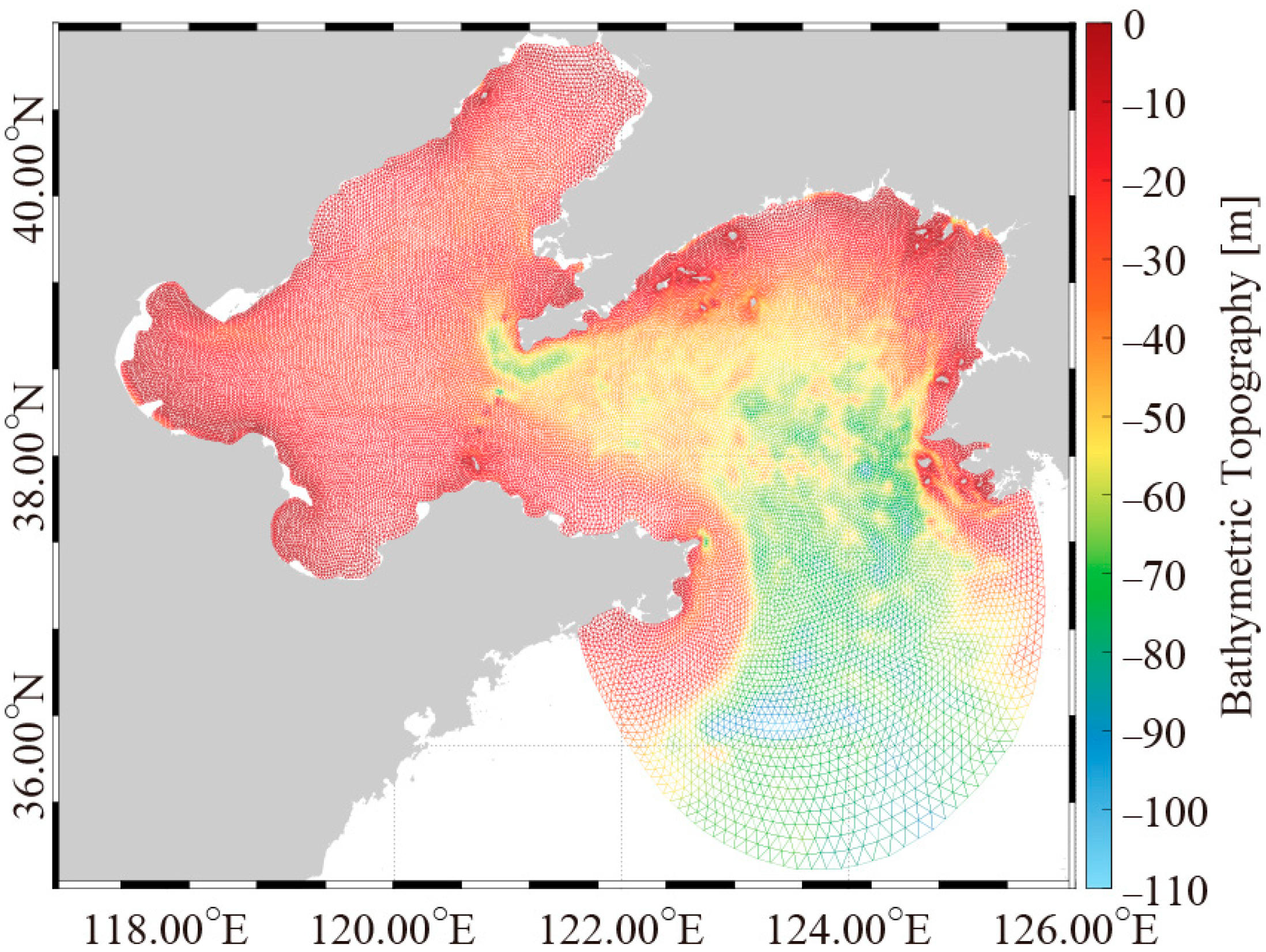

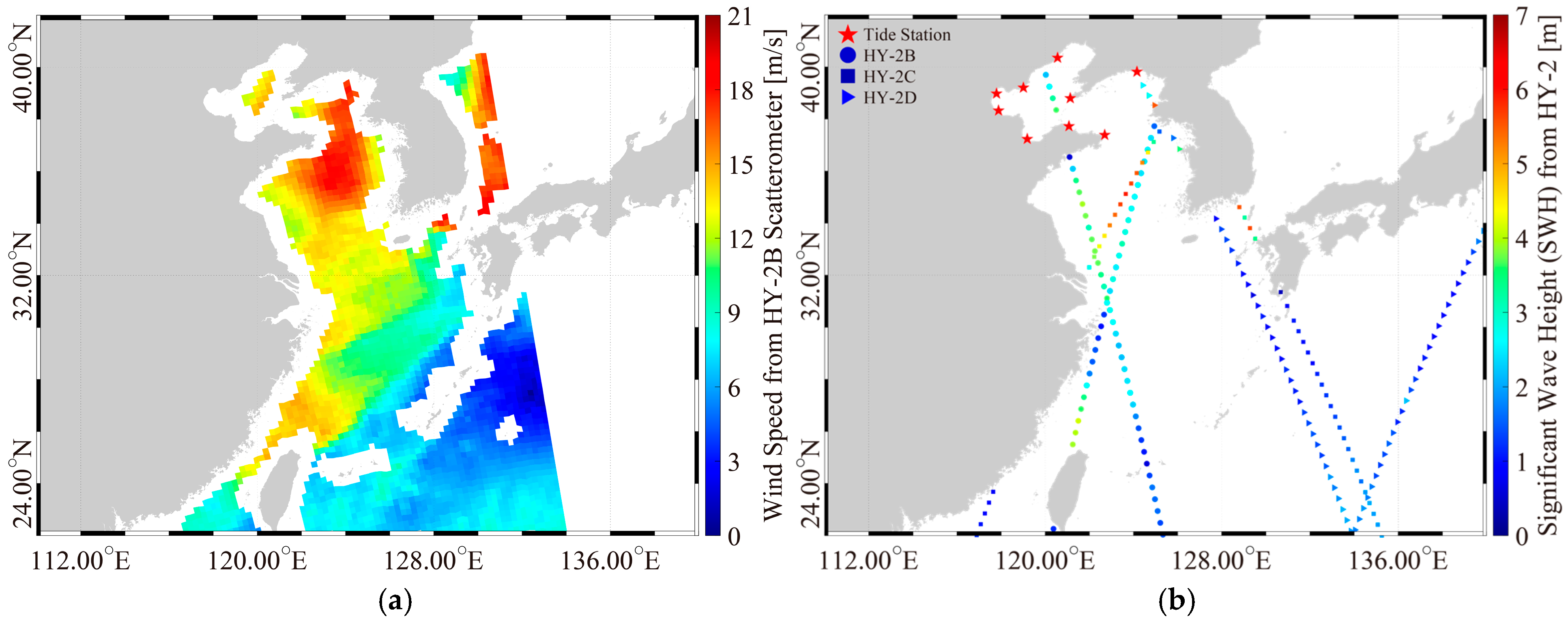
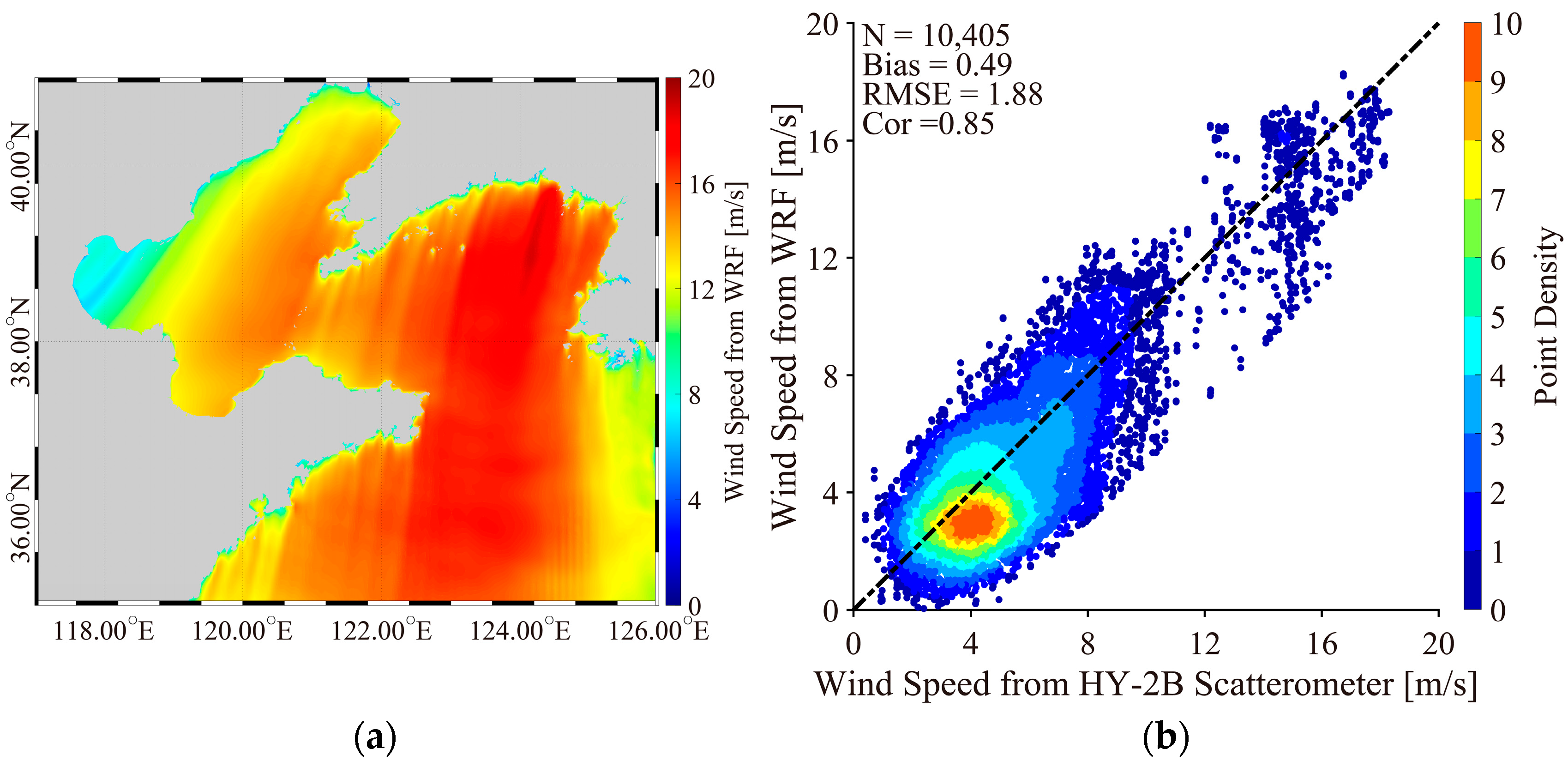



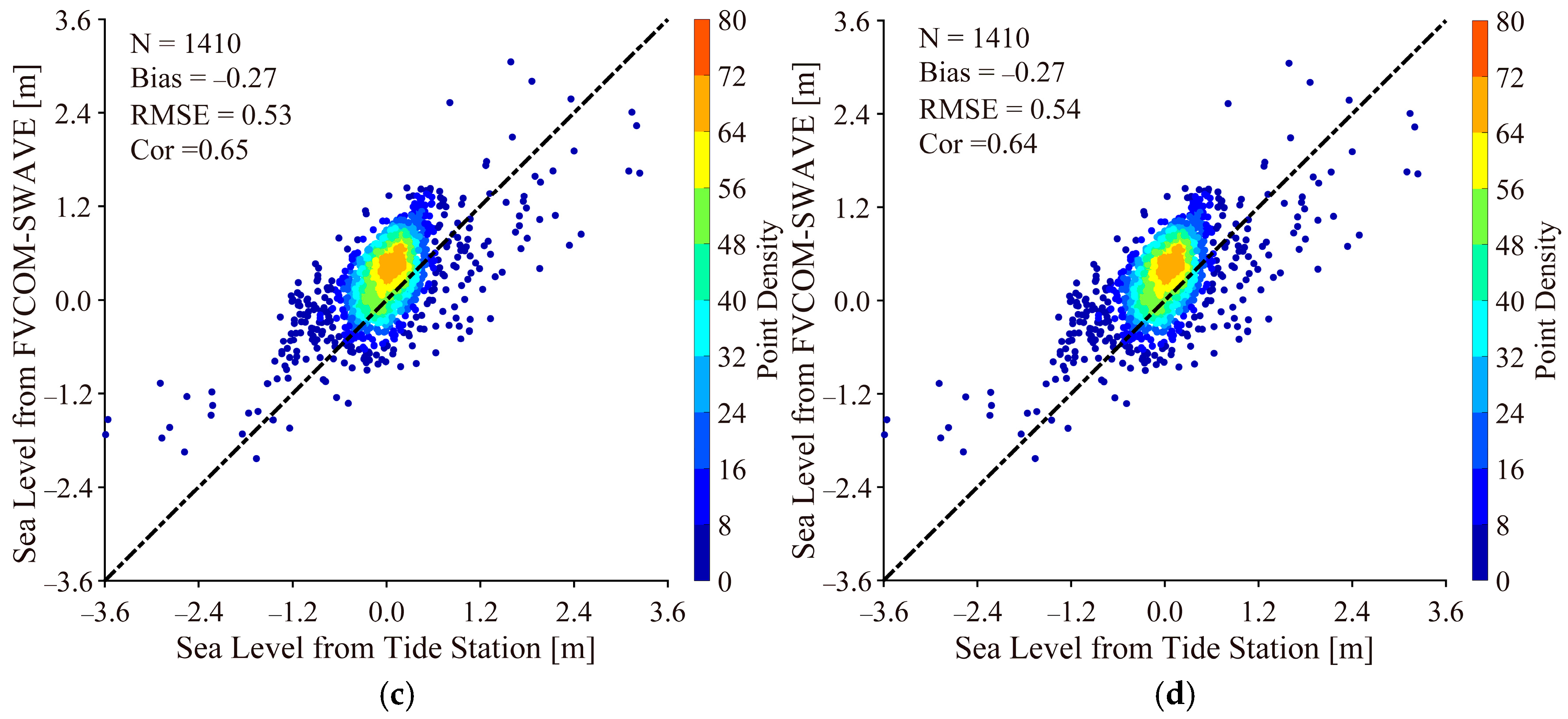
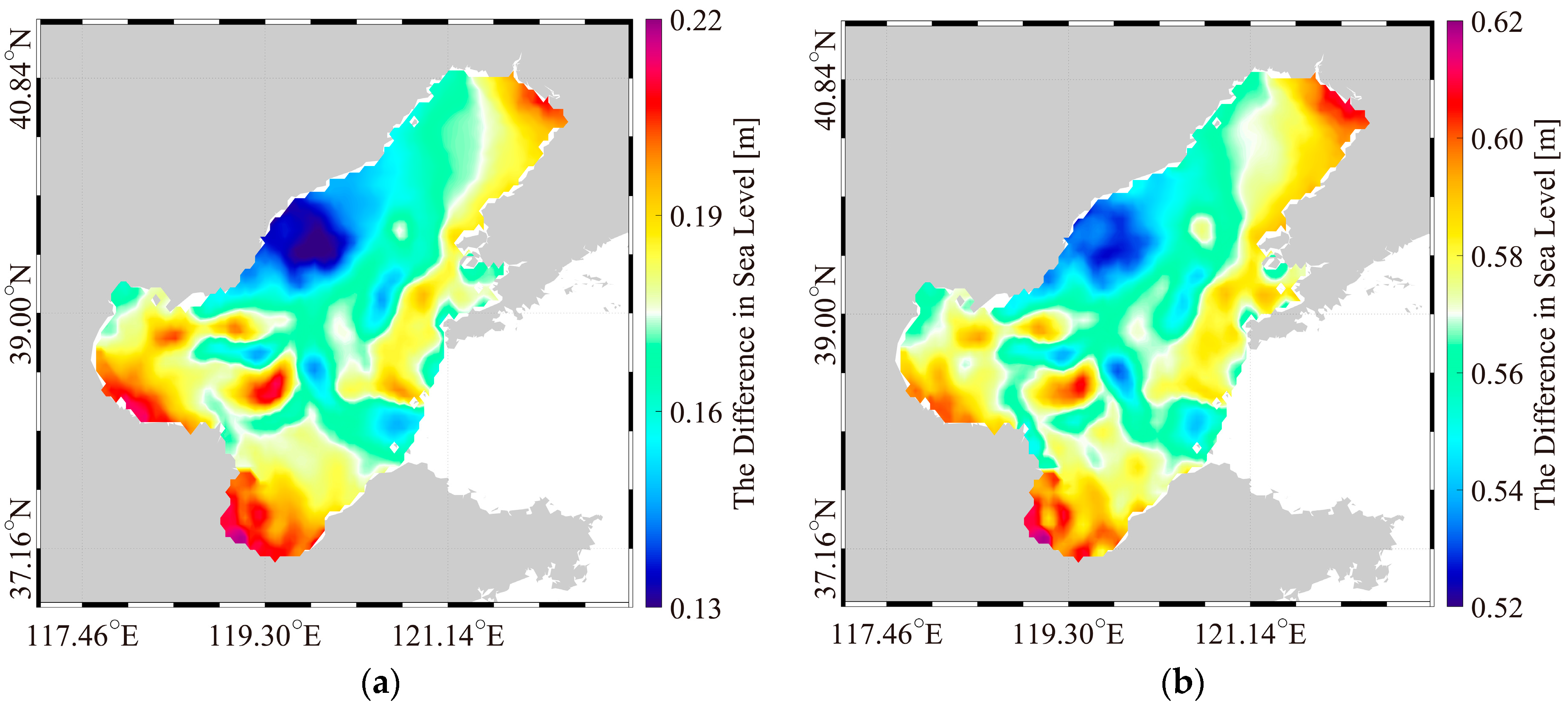
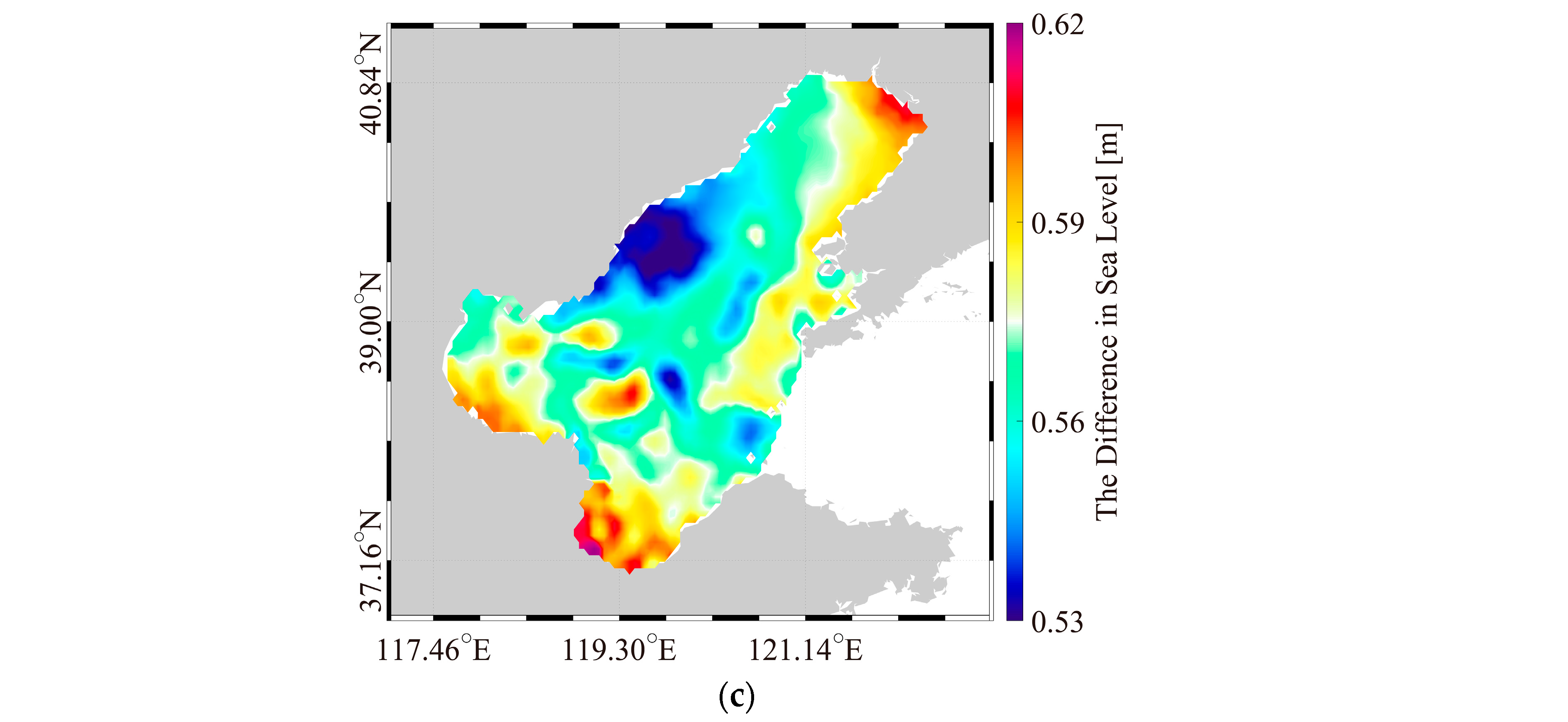

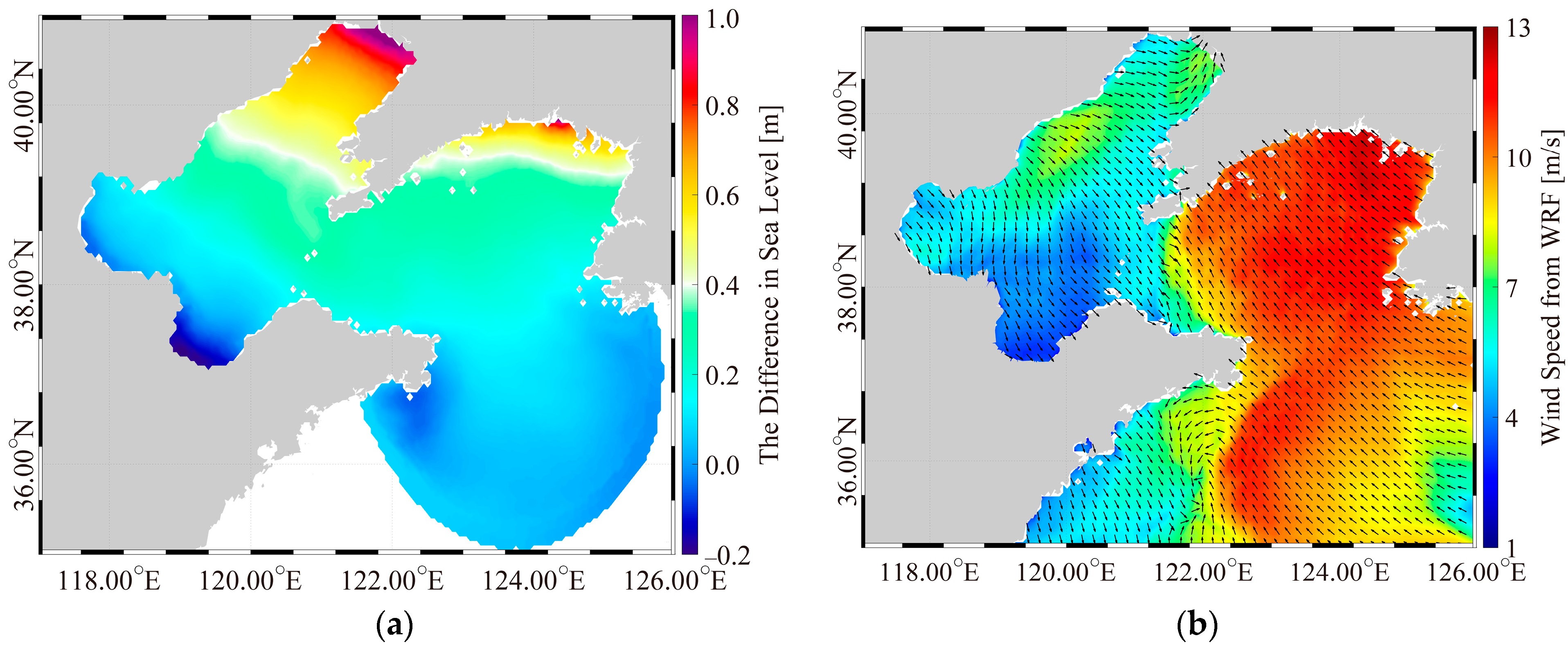
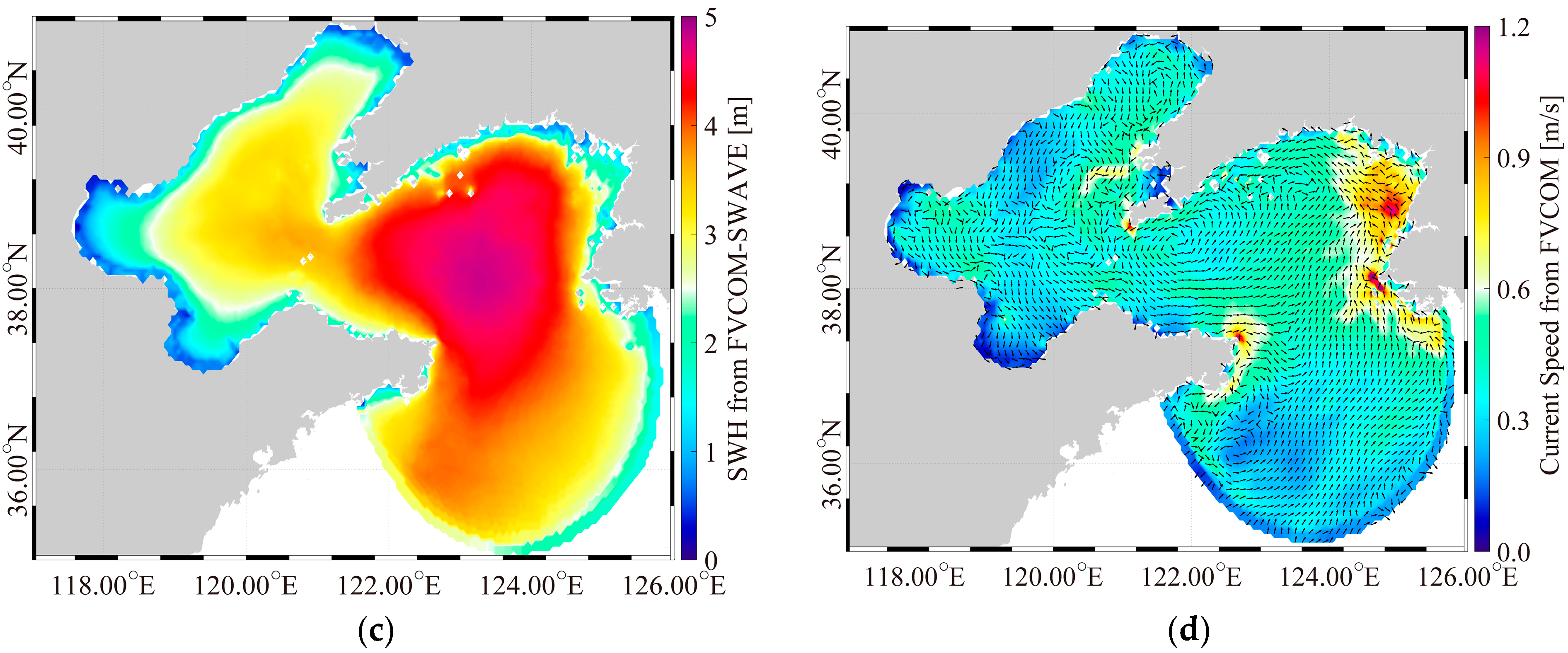
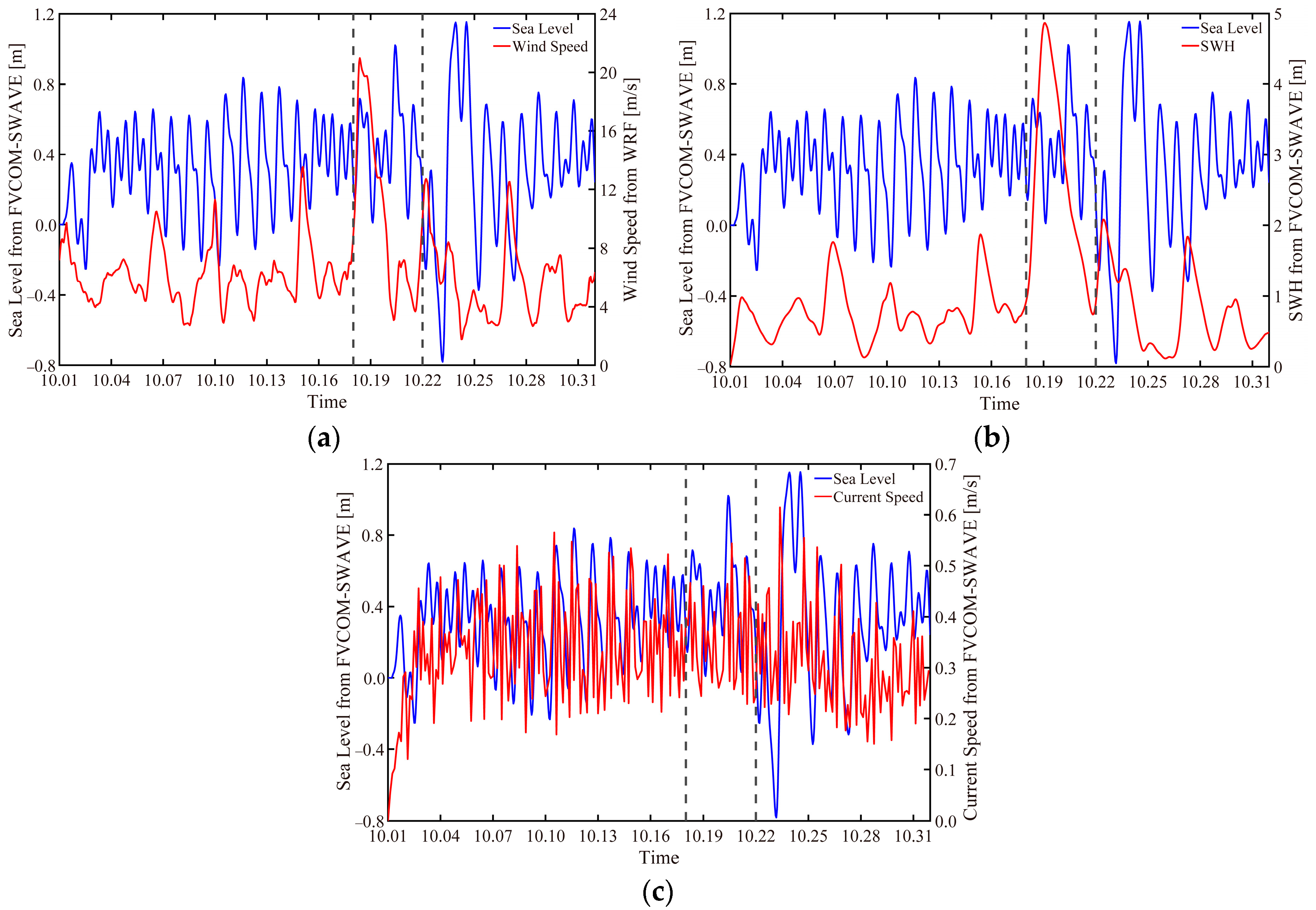
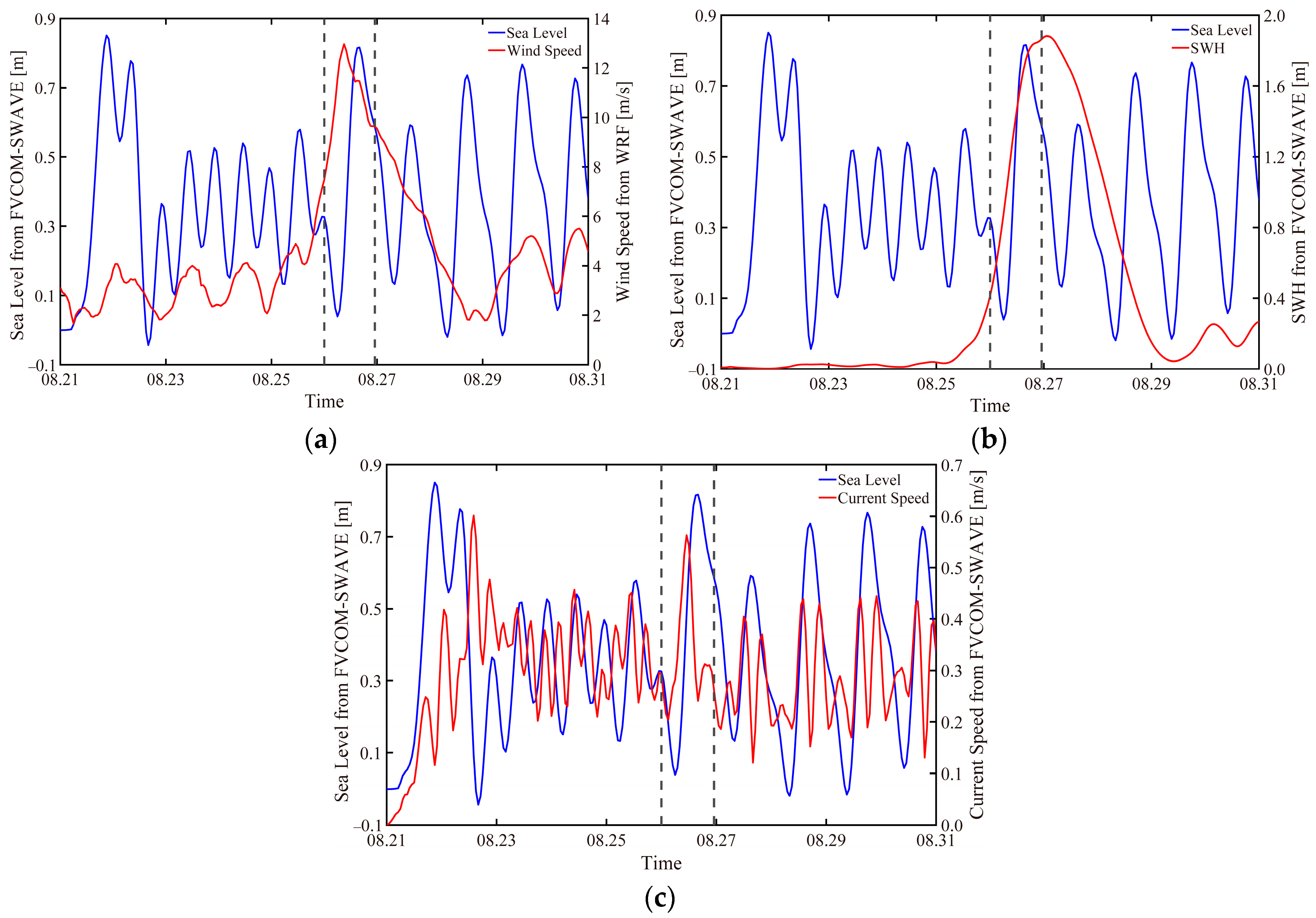
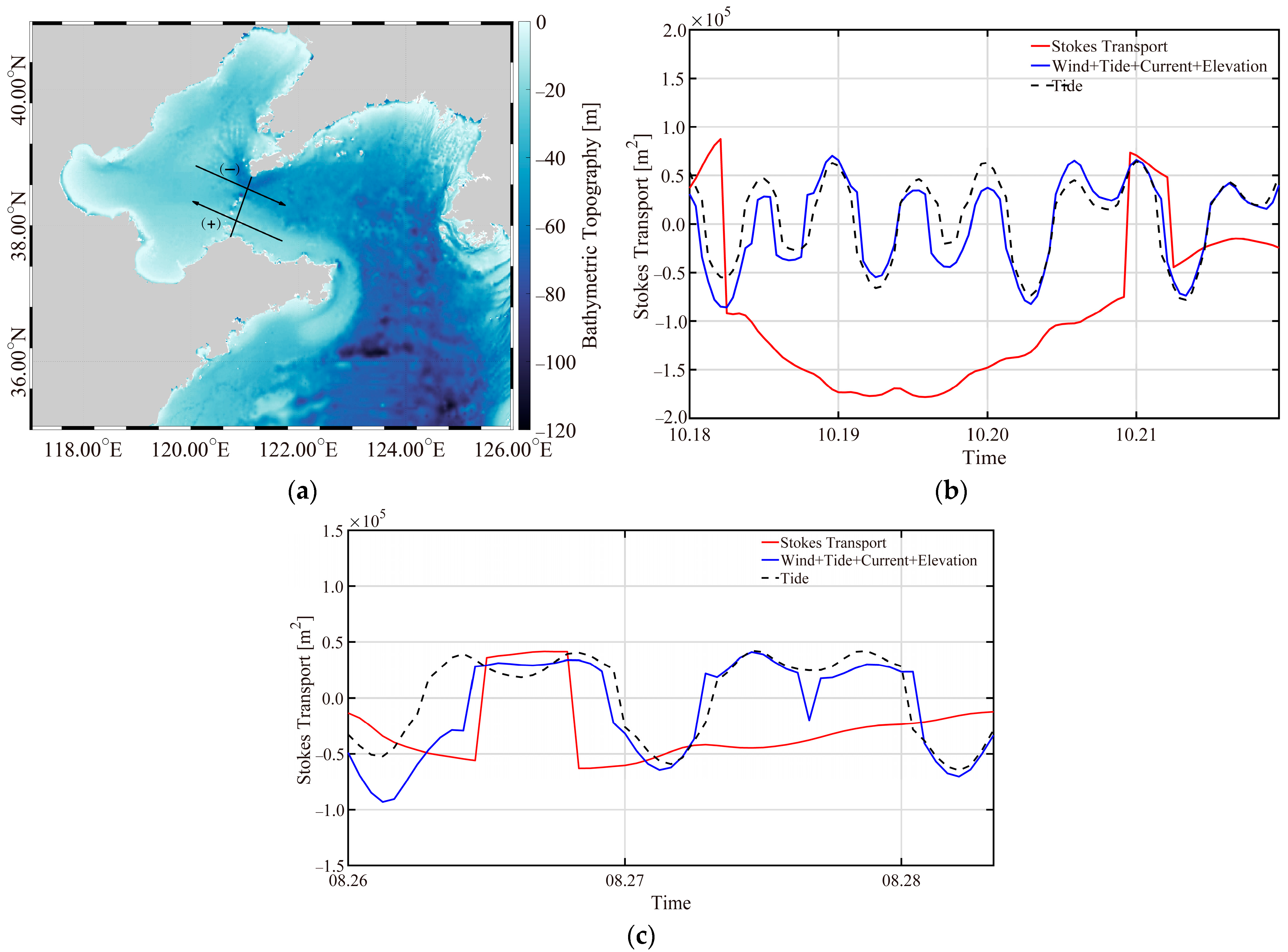
Disclaimer/Publisher’s Note: The statements, opinions and data contained in all publications are solely those of the individual author(s) and contributor(s) and not of MDPI and/or the editor(s). MDPI and/or the editor(s) disclaim responsibility for any injury to people or property resulting from any ideas, methods, instructions or products referred to in the content. |
© 2025 by the authors. Licensee MDPI, Basel, Switzerland. This article is an open access article distributed under the terms and conditions of the Creative Commons Attribution (CC BY) license (https://creativecommons.org/licenses/by/4.0/).
Share and Cite
Pan, S.; Liu, L.; Hu, Y.; Zhang, J.; Jia, Y.; Shao, W. Analysis of Abnormal Sea Level Rise in Offshore Waters of Bohai Sea in 2024. J. Mar. Sci. Eng. 2025, 13, 1134. https://doi.org/10.3390/jmse13061134
Pan S, Liu L, Hu Y, Zhang J, Jia Y, Shao W. Analysis of Abnormal Sea Level Rise in Offshore Waters of Bohai Sea in 2024. Journal of Marine Science and Engineering. 2025; 13(6):1134. https://doi.org/10.3390/jmse13061134
Chicago/Turabian StylePan, Song, Lu Liu, Yuyi Hu, Jie Zhang, Yongjun Jia, and Weizeng Shao. 2025. "Analysis of Abnormal Sea Level Rise in Offshore Waters of Bohai Sea in 2024" Journal of Marine Science and Engineering 13, no. 6: 1134. https://doi.org/10.3390/jmse13061134
APA StylePan, S., Liu, L., Hu, Y., Zhang, J., Jia, Y., & Shao, W. (2025). Analysis of Abnormal Sea Level Rise in Offshore Waters of Bohai Sea in 2024. Journal of Marine Science and Engineering, 13(6), 1134. https://doi.org/10.3390/jmse13061134







